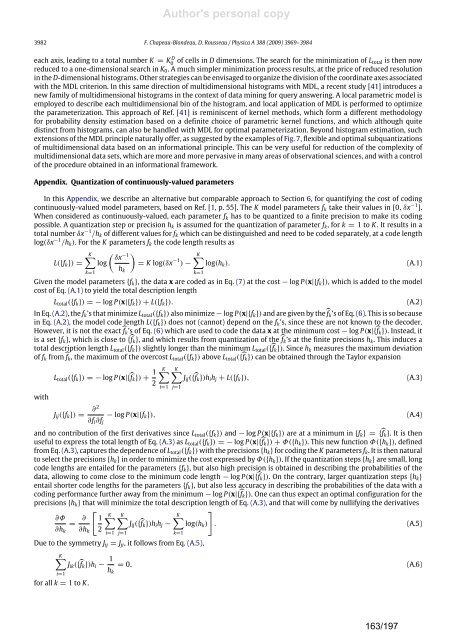a la physique de l'information - Lisa - Université d'Angers
a la physique de l'information - Lisa - Université d'Angers
a la physique de l'information - Lisa - Université d'Angers
You also want an ePaper? Increase the reach of your titles
YUMPU automatically turns print PDFs into web optimized ePapers that Google loves.
Author's personal copy<br />
3982 F. Chapeau-Blon<strong>de</strong>au, D. Rousseau / Physica A 388 (2009) 3969–3984<br />
each axis, leading to a total number K = K D<br />
0 of cells in D dimensions. The search for the minimization of Ltotal is then now<br />
reduced to a one-dimensional search in K0. A much simpler minimization process results, at the price of reduced resolution<br />
in the D-dimensional histograms. Other strategies can be envisaged to organize the division of the coordinate axes associated<br />
with the MDL criterion. In this same direction of multidimensional histograms with MDL, a recent study [41] introduces a<br />
new family of multidimensional histograms in the context of data mining for query answering. A local parametric mo<strong>de</strong>l is<br />
employed to <strong>de</strong>scribe each multidimensional bin of the histogram, and local application of MDL is performed to optimize<br />
the parameterization. This approach of Ref. [41] is reminiscent of kernel methods, which form a different methodology<br />
for probability <strong>de</strong>nsity estimation based on a <strong>de</strong>finite choice of parametric kernel functions, and which although quite<br />
distinct from histograms, can also be handled with MDL for optimal parameterization. Beyond histogram estimation, such<br />
extensions of the MDL principle naturally offer, as suggested by the examples of Fig. 7, flexible and optimal subquantizations<br />
of multidimensional data based on an informational principle. This can be very useful for reduction of the complexity of<br />
multidimensional data sets, which are more and more pervasive in many areas of observational sciences, and with a control<br />
of the procedure obtained in an informational framework.<br />
Appendix. Quantization of continuously-valued parameters<br />
In this Appendix, we <strong>de</strong>scribe an alternative but comparable approach to Section 6, for quantifying the cost of coding<br />
continuously-valued mo<strong>de</strong>l parameters, based on Ref. [1, p. 55]. The K mo<strong>de</strong>l parameters fk take their values in [0, δx −1 ].<br />
When consi<strong>de</strong>red as continuously-valued, each parameter fk has to be quantized to a finite precision to make its coding<br />
possible. A quantization step or precision hk is assumed for the quantization of parameter fk, for k = 1 to K . It results in a<br />
total number δx −1 /hk of different values for fk which can be distinguished and need to be co<strong>de</strong>d separately, at a co<strong>de</strong> length<br />
log(δx −1 /hk). For the K parameters fk the co<strong>de</strong> length results as<br />
K<br />
−1<br />
δx<br />
L({fk}) = log = K log(δx −1 K<br />
) − log(hk). (A.1)<br />
k=1<br />
hk<br />
k=1<br />
Given the mo<strong>de</strong>l parameters {fk}, the data x are co<strong>de</strong>d as in Eq. (7) at the cost − log P(x|{fk}), which is ad<strong>de</strong>d to the mo<strong>de</strong>l<br />
cost of Eq. (A.1) to yield the total <strong>de</strong>scription length<br />
Ltotal({fk}) = − log P(x|{fk}) + L({fk}). (A.2)<br />
In Eq. (A.2), the fk’s that minimize Ltotal({fk}) also minimize − log P(x|{fk}) and are given by the fk’s of Eq. (6). This is so because<br />
in Eq. (A.2), the mo<strong>de</strong>l co<strong>de</strong> length L({fk}) does not (cannot) <strong>de</strong>pend on the fk’s, since these are not known to the <strong>de</strong>co<strong>de</strong>r.<br />
However, it is not the exact fk’s of Eq. (6) which are used to co<strong>de</strong> the data x at the minimum cost − log P(x|{ fk}). Instead, it<br />
is a set {fk}, which is close to { fk}, and which results from quantization of the fk’s at the finite precisions hk. This induces a<br />
total <strong>de</strong>scription length Ltotal({fk}) slightly longer than the minimum Ltotal({ fk}). Since hk measures the maximum <strong>de</strong>viation<br />
of fk from fk, the maximum of the overcost Ltotal({fk}) above Ltotal({ fk}) can be obtained through the Taylor expansion<br />
with<br />
Ltotal({fk}) = − log P(x|{ fk}) + 1<br />
Jij({fk}) =<br />
∂ 2<br />
∂fi∂fj<br />
2<br />
K<br />
i=1<br />
K<br />
Jij({fk})hihj + L({fk}), (A.3)<br />
j=1<br />
− log P(x|{fk}), (A.4)<br />
and no contribution of the first <strong>de</strong>rivatives since Ltotal({fk}) and − log P(x|{fk}) are at a minimum in {fk} = {fk}. It is then<br />
useful to express the total length of Eq. (A.3) as Ltotal({fk}) = − log P(x|{fk}) + Φ({hk}). This new function Φ({hk}), <strong>de</strong>fined<br />
from Eq. (A.3), captures the <strong>de</strong>pen<strong>de</strong>nce of Ltotal({fk}) with the precisions {hk} for coding the K parameters fk. It is then natural<br />
to select the precisions {hk} in or<strong>de</strong>r to minimize the cost expressed by Φ({hk}). If the quantization steps {hk} are small, long<br />
co<strong>de</strong> lengths are entailed for the parameters {fk}, but also high precision is obtained in <strong>de</strong>scribing the probabilities of the<br />
data, allowing to come close to the minimum co<strong>de</strong> length − log P(x|{fk}). On the contrary, <strong>la</strong>rger quantization steps {hk}<br />
entail shorter co<strong>de</strong> lengths for the parameters {fk}, but also less accuracy in <strong>de</strong>scribing the probabilities of the data with a<br />
coding performance further away from the minimum − log P(x|{fk}). One can thus expect an optimal configuration for the<br />
precisions {hk} that will minimize the total <strong>de</strong>scription length of Eq. (A.3), and that will come by nullifying the <strong>de</strong>rivatives<br />
∂Φ<br />
= ∂<br />
<br />
<br />
K K<br />
K<br />
1<br />
Jij({fk})hihj − log(hk) . (A.5)<br />
2<br />
∂hk<br />
∂hk<br />
i=1<br />
j=1<br />
k=1<br />
Due to the symmetry Jij = Jji, it follows from Eq. (A.5),<br />
K<br />
Jik({fk})hi − 1<br />
= 0, (A.6)<br />
i=1<br />
for all k = 1 to K .<br />
hk<br />
163/197


